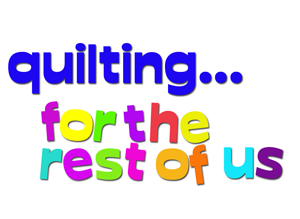Recently I read an article from Quilting Arts Magazine when I was in a bit of a weak spot, I suppose, and I immediately bit and ordered the foot it spoke of, without reading any reviews of the foot first. Fortunately, I wasn't overly disappointed--I think I've probably used enough of these tools now to know none of them is perfect. The product in question is a free motion couching foot for Janome machines*. Couching is when you hold one larger cord or yarn down on fabric by crossing back and forth over it with a smaller thread--you can do it by hand, of course, or you can do it with a sewing machine by using a zig-zag stitch. I've done it by machine a handful of times; it works okay, but it's hard to do tight or really smooth curves by the standard methods. I thought this FMQ couching foot may be the answer.
It is, partly. I give it maybe a 6 out of 10--possibly a 7 if I have more practice with it.
I talked about this foot on my podcast episode this week, so here are the photos that may help illustrate some of the drawbacks I talked about.
It comes with two sizes of feet in the package; one with a slightly larger hole and one slightly smaller. It would probably take some trial and error to figure out which foot you need for the yarn/cording you're trying to use.
Here's how you thread it--it was a little tricky to get the yarn up and over from the back of the foot. It involved lots of bending over and squinting, but I persevered.
You have to pay attention to the settings the package tells you to use for your needle. I broke my first needle. Oops. There's a very tight little hole for that needle to zig-zag over the couched thread so you've got to make sure the zig-zag settings are correct.
The package suggests to allow the cording/yarn that you're couching to "pool" behind the foot. Believe them. It really needs a lot of slack to work right--every time it used up the pool and started feeding right off the little ball of yarn I had, it would start skipping stitches and missing the yarn altogether. This might be tricky if you were couching on a larger project that would limit the amount of space you have for pooling the yarn; I was just doing a small test piece so I didn't have any problem.
As long as you move slowly and work with the limitations, it does actually work. Here's some of what I was able to do. This is all free-hand; I didn't sketch anything out ahead so I was truly, truly free-motioning.
Normally I'd probably use an invisible or matching thread so the thread wouldn't be visible; I used a beige thread because that's what happened to be in my machine at the time, and this was just a test. Plus, I thought it might be helpful to be able to see the stitches. (The metallic thread you see sticking out is actually part of the yarn.)
The stitch tended to shred this particular yarn--it would work better with a tighter ply, or a cording. Still, this sort of "foamy" look could be cool if that's what you're going for. Just test any cording you're planning to couch with this foot first to make sure you're getting the results you expect.
The foot works remarkably well, really, given that the concept of couching and the concept of free motion quilting are sort of counter to one another. The only consistent time I had problems (other than when the yarn wasn't pooled loosely enough behind the foot) was when I moved left to right. It missed the yarn just about every time. That's where I'd have to do more experimenting to see if I could figure out a way to counterbalance that.
Anyway, using the free motion couching foot worked better than doing the same thing with a regular foot. It still has weaknesses, but with what I'm doing, they probably aren't huge weaknesses. The long and short of it is, I'm glad I got this foot; I think it'll be fun to play with in the future.
*There are also FMQ couching feet for other brands of machines. Just Google!




